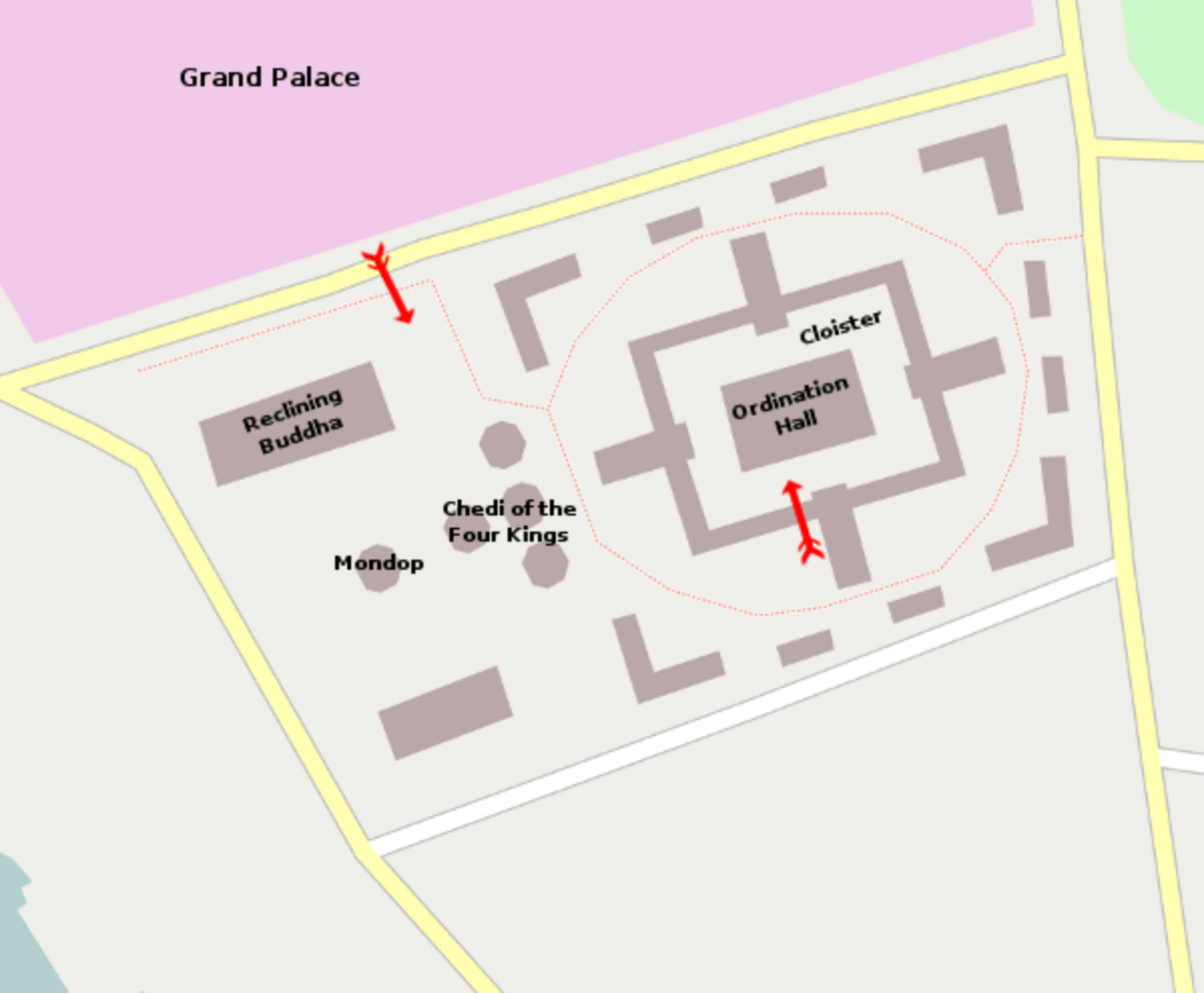You can take it with you.
Wish you could have this information with you when you visit Wat Po? Now you can. Check out our Bangkok Essentials ebook.
Just behind the opulent extravagance of the Temple of the Emerald Buddha stands Wat Phra Chetuphon, which is more commonly known by its old name of Wat Po. Most western tourists don't get past the temple's huge reclining Buddha, but there is actually much more to see than the one colossal statue.
The temple is actually much older than the city of Bangkok itself. It was founded in the seventeenth century, making it the oldest temple in Bangkok. The name Wat Po comes from its original name of Wat Potaram. King Rama I, the founder of Bangkok, enlarged the temple, installed many statues and other artifacts recovered from Ayutthaya, and renamed the temple Wat Phra Chetuphon in 1801.
Rama III enlarged the temple in 1832 and turned the temple into a center of learning, making it in essence Thailand's first university. Rama III is also responsible for the construction of the reclining Buddha. The Wiharn housing the reclining Buddha is just barely big enough to hold the statue, which is why you never seen any wide shots of the whole thing.
In addition to the fine features of the Buddha's face, also of note are the soles of the Buddha's feet, 45 meters (150 feet) away from the head, which have been inlaid with mother-of-pearl to display the 108 auspicious signs which distinguish a true Buddha.

Next to the Reclining Buddha wiharn is an enclosure holding the four largest of the temple's 95 pagodas. All of these chedis at Wat Po are square, rather than the round bell shape generally preferred at the time. They are decorated with ceramic tiles and three dimensional ceramic pieces which form intricate floral patterns. The center of the three chedi in a line is the oldest, having been built by Rama I to hold the Phra Si Sanphet Buddha image bought from Ayutthaya. Later, Rama III built the chedi north of this to hold the ashes of Rama II, and the one to the south to hold his own remains. The fourth chedi was built by Rama IV for unknown purposes.
Behind the courtyard containing the chedis of the four kings is a mondop holding sacred Buddhist scriptures. You may be surprised to see that the mondop and surrounding small buildings are air-conditioned but not open to the public. The reason is that the scriptures housed here are very old and inscribed on palm leaves. The buildings are climate controlled to preserve the delicate documents.
Just outside the courtyard holding the royal chedis are a couple of pavilions displaying plaques and instruments involved in traditional medicine. These face the main ubosot which sits in a cloister with large pavilions on each of the four sides. Each of the pavilions contains a Buddha image set up in a different style. The pavilion facing the royal chedis is a bit larger than the others, and behind the Buddha image is a small museum. Note, however, that you can't get through any of these pavilions into the cloister.
To get to the ubosot, you need to walk round to the south side of the cloister and enter through one of the doors on either side of the pavilion on that side. The cloister is a double-ringed affair housing nearly 400 Buddha images, with the ubosot in the middle. Before entering the ubosot, note the gray stone plaques around the base. These illustrate the Ramakien, the Thai version of the Hindu epic, the Ramayama, in 152 plaques. The stones were recovered from a temple in Ayutthaya and installed here by Rama I. Rubbings on these plaques used to be hawked relentlessly just outside the temple walls, but seem to have gone out of fashion.
Inside the ubosot is a magnificent alter with a large Buddha, all finished in gold and crystal. Outside the ubosot, but within the cloister, you can sometimes find classical mask-makers demonstrating their art.
If you exit the cloister through the north side and turn right, you'll find the massage pavilions at the far end of the temple compound. The temple is still considered the pre-eminent place of learning for the ancient Thai medicinal art. You can get a massage at the temple, or even sign up for courses to learn Thai massage yourself.
When visiting Wat Po, you may want to consider combining your visit with one or more of the following nearby attractions:
Getting There
The easiest way to get to Wat Po is by boat. Take the Chao Phraya River Express to the Tha Thien pier, then walk through the market and up the short street. Wat Po is directly across the intersection, on your right. On the left is the rear wall of the Grand Palace.
Entrance Fee
Visitors must pay an entrance fee of 100 Baht (2.60 USD) at booths just inside the north, or south, entrances.
Prices for a massage at the temple are 250 Baht (6.49 USD) for 30 minutes, or 400 Baht (10.39 USD) for one hour massage or a 45 minute foot massage.